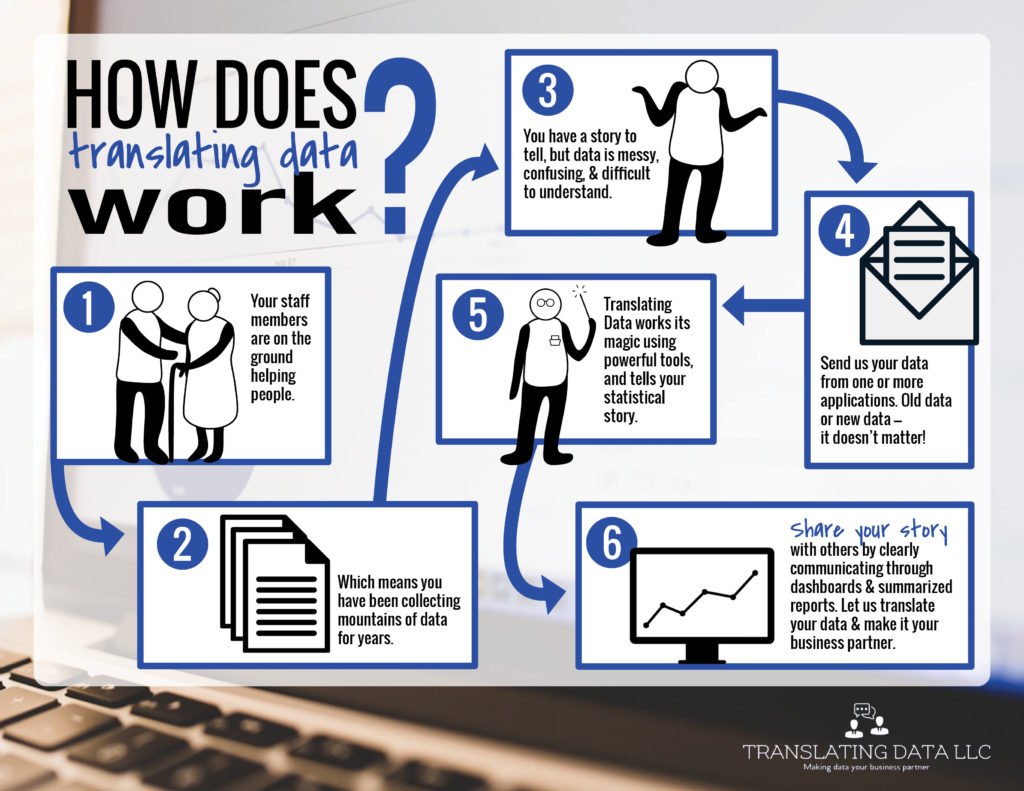You know when something big happens, like you’re thinking about buying a new house, but you aren’t sure it’s going to work out, so you don’t want to tell any of your friends quite yet?
That’s how we’ve been feeling.
But no more! We’re ready to announce our exciting news. We’ve entered into a strategic partnership with a company we are thrilled about. Really thrilled. We want to introduce you today to a new company called Translating Data.
Why is this so exciting? Well, Translating Data may be brand new, but it is already making a splash in its niche, which is social services data. That’s because it is providing a much-needed service. Companies are contacting Translating Data to seek its services, rather than the other way around. Translating Data is all about helping people through technology. So you see, for RoboSource and Translating Data to join forces, well, it’s a match made in heaven.
So today, we want to tell you all about Translating Data and the difference it’s already making. We’re pretty excited to be along for the ride, and getting to take on the software engineering part of the process. But we figured it might be best coming from the founder, Paul Watkins. Here’s an introduction to the company, in his own words:
Okay, Paul, let’s start with the basics. What is Translating Data?
 Translating Data is a company that levels the data-driven playing field to allow smaller organizations to compete or collaborate with larger corporations.
Translating Data is a company that levels the data-driven playing field to allow smaller organizations to compete or collaborate with larger corporations.
We give businesses and Community-Based Organizations (CBOs) the tools and support they need to analyze and understand the data collected. Our goal is to allow our customers to tell the story behind their data. We do this by consuming data from one or more sources, validating and standardizing it, and running an analysis to provide a summary of outcomes that can be used to make business decisions.
Translating Data applies a grassroots approach to understanding each business’s and CBO’s model of operating. We then use the findings from analyzing their data to identify strengths and gaps in the services they provide. These results are summarized to identify areas of growth for existing programs and services, clearly communicate expectations with staff, and pursue new lines of business.
In plain English, this means that you’re helping organizations interpret data they are required to collect, and use it to gain additional funding or find new ways to help people, right? Is that the gist of it?
Sure. That’s another way to put it. Here’s a quick graphic that shows the basics, too.

Paul, how did you end up starting Translating Data? How did you get to where you are today?
The vast majority of my career has been spent in the social services field. My wife and I got started in the Peace Corps focusing on community development activities. When we returned stateside, I received a Masters of Social Work from the University of Missouri St. Louis. During that time I worked with a behavioral health agency, Goodwill Industries, and the St. Louis Area Agency on Aging. I have since moved to Indianapolis where I was able to continue working with Area Agencies on Aging (AAAs) with a focus on business development activities.
The implementation of the Affordable Care Act put an emphasis on healthcare providers and insurance companies focusing on the cost, quality, and care of patients. This has since provided opportunities for CBOs such as AAAs to partner with the healthcare industry to obtain better outcomes for patients.
Wow, that’s a lot of acronyms, but I think I’m following. So how will Translating Data be helping real people?
Many CBOs have collected data on the populations they have served for years. But it can be difficult to understand and consolidate data from the many systems each agency is using to serve a single population. Translating Data is now consolidating information from one or more applications, new or old (it doesn’t matter), to provide clarity to the healthcare industry about the great work CBOs have been doing for years.
We also understand it can be easy to present statistical information. What can be really complicated is knowing what to do with that information and how to tell the story behind it. Translating Data works closely with our customers to help them tell their life-changing stories from a data-driven perspective.
That makes sense. So what’s the impact for Community-Based Organizations?
Ideally, our impact would provide clarity for CBOs to communicate in effective ways with the healthcare industry about the populations they serve. And we’ll help them tell the story about the impact their work is having on health outcomes. There’s also the more mundane side of things: we provide the data health systems are accustomed to looking for as a means to validate the interventions they would like to contract for with CBOs.
Ah. Government funding, you mean? Translating Data helps CBOs provide proof of the work they are already doing. So who should be paying attention to this new opportunity?
Our ideal customers tend to be small to mid-size organizations that have a minimum set of data, such as demographic information about the people they serve. Really, a lot of different companies could fit into that description.
Is there anything else people need to know?
One thing comes to mind: what we’ve found is that everyone thinks their data is not enough or “bad” data. While it’s true that not all data is useful, almost every business has some kind of data that can be built upon to grow and/or streamline their business. We have the tools to locate the power behind their data, no matter how big, small, old, or new it is. We have found there is always something to be learned from the information they are collecting.
Okay, Paul, how can people find out more info?
Obviously, we aren’t a fit for everyone, but I do like to talk to anyone who is willing to chat about where they are at today and what they would potentially like to do now and in the future. Feel free to contact me at paulwatkins@translatingdata.net .
So that’s Translating Data. And our latest big news. What’s new with you?

Recent Comments